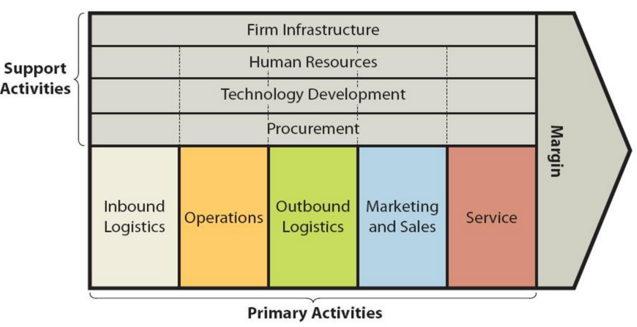
Value chain analysis is a strategic analytical and decision-support tool that highlights the bases where businesses can create value for their customers. The framework can also be applied to identify sources of competitive advantage for businesses. Value chain is a set of consequent activities that businesses perform in order to achieve their primary objective of profit maximization. Most sources explain the essence and application of value chain analysis assuming their audience is businesses aiming to increase the level of their competitiveness. Here, we adopt an alternative approach. Below is an explanation of value chain analysis for business students who have been assigned to apply this strategic analytical tool as part of assignment given by their educational institution. Theory of Value Chain Analysis The concept value chain analysis was introduced by Michael Porter in 1985[1] and its significance and relevance to strategic management and marketing has not diminished during 30 years of its existence. The framework divides activities that generate value into two categories – primary activities and support activities. Primary activities comprise a set of activities that contribute to the creation of value in a direct manner. Support activities consist of functions and tasks that are intended to support primary activities. It is important to clarify that the relevance of value chain analysis is not limited to manufacturing businesses and the framework can be applied towards service firms as well. Primary Activities Inbound logistics involve receiving and storing raw materials and their usage in manufacturing as the necessity arises. Operations relate to the processes of transforming raw materials into finished goods. For businesses operating in services sector operations relate to the process of providing the service. Outbound logistics is associated with warehousing and distribution of finished products. Marketing and sales refer to the choice and implementation of marketing strategy to communicate…
Strategy is “means to ends, and these ends concern the purpose and objectives of the organization”[1]. Strategy is “used in business to describe how an organization is going to achieve its objectives”[2]. It has been noted that “strategy is about marshalling the gross resources of the organization to match the needs of the marketplace and achieve the business objective, this cannot be a short-term activity”[3]. In simple terms, business strategy “consists of what management decides about the future direction and scope of the business”[4]. There is a wide range of strategic analytical tools, models and frameworks that can assist with the various aspects of development and implementation of business strategy. These include the following: Gaps Model of Service Quality Greenfield investment McKinsey 7s Model New market entry strategies PESTEL analysis Porter’s Five Forces analysis Strategy as Revolution SWOT analysis “Think Globally, Act Locally”: a critical analysis Value chain analysis Some of the above (hyperlinked) are explained in this portal. The list above is going to be regularly expanded to include in-depth explanation of the most important strategic analytical tools, models and frameworks. [1] Thompson, J.L. & Martin, F. (2010) “Strategic Management: Awareness & Change” Cengage Learning [2] Sekhar, G.V.S. (2010) “Business Policy and Strategic Management” I.K. International Pvt Ltd [3] Fiflied, P. (2012) “Marketing Strategy” 3rd edition, Routledge [4] Rao, C.A., Rao, B.P. & Rao, K. (2009) “Strategic Management and Business Policy: Text and Cases” Excel Books
Theory can be defined as “a formal logical explanation of some events that includes predictions of how things relate to one another”[1]. Concepts are “collectives used to label certain bits of experience. In other words, they are elementary constructs by which reality is classified and categorised”[2]. Alternatively, concepts are “mental constructs or images developed to symbolise ideas, persons, things, or events”[3] Model can be defined as “a set of ideas and numbers that describe the past, present or future state of something”[4] A framework is “a system of rules, laws, agreements, etc. that establish the way that something operates”[5] A tool is “a thing used to perform a job”[6]. There are many theories, concepts, models, frameworks and tools in the area of business that you will have to use at some stage of your studies. The following are the most popular ones listed in alphabetical order: Change Kotter’s Eight Steps Model Lewin’s Force-Field Theory of Change Lewin’s Model of Change Consumer behavior Behaviorist approach to consumer behavior Cognitive approach to consumer behavior Consumer buyer behavior Consumer decision making process Customer perceived value Economic Man approach to consumer behavior Model of Goal Directed Behavior Psychodynamic Approach to consumer behavior Theory of Trying Corporate Social Responsibility Approaches to CSR Carrol’s CSR Pyramid Code of Ethics Culture Cross-cultural competencies Cross-cultural management Elements of organizational culture Harrison’s Model of Culture Hofstede’s Cultural Dimensions Trompenaars and Hampden-Turner Cultural Dimensions Economics Foreign Direct Investment Inter-industry and intra-industry trade Liberal and coordinated market economies Specialization for developing countries Theory of absolute advantage Theory of comparative advantage Human Resources Management Cognitive Theory of Training Transfer Continuous Professional Development Equity Theory of Motivation Employee training and development Forms of training transfer Frederick Hertzberg’s Two Factor Theory Hertzberg’s Motivation and Hygiene Factors Honey and…
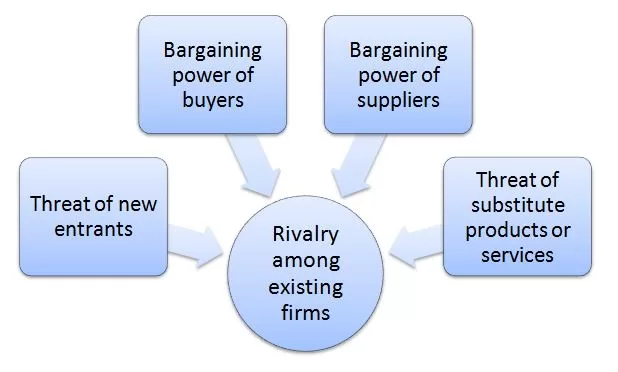
Porter’s Five Forces is a strategic analytical tool that is used to assess the level of intensity of competition in the industry. The tool can also be applied to evaluate the balance of power in the industry. Developed by a famous strategy guru Michael Porter[1], the framework assumes that the level of intensity of competition in the industry. Threat of new entrants High level of profit in a market or industry attracts new companies to join the industry affecting the level and pattern of competition in the marketplace. Theoretically, firms should be able to enter and exit to maintain the nominal level of profits. In practice, however, there is a range of factors that may emerge as a barrier for firms aiming to enter an industry. Specifically, the threat of new entrants depends on the following set of factors: Economies of scale. Product differentiation Capital requirements. Customer switching costs Access to distribution channels Legal and regulatory barriers Expected retaliation from existing businesses Time of entry Specialist knowledge Cost advantages Technology protection Bargaining power of buyers Buyer bargaining power is associated with the extent of impact customers can have on the industry. The stronger the buyer, the greater his ability to reduce prices and/or increase the quality of products and services. The following set of factors determine bargaining power of buyers: Size and concentration of buyers compared to suppliers Buyers’ price sensitivity Product differentiation Switching costs Information about products and services Buyer’s ability to go for substitute products and services Bargaining power of suppliers Supplier bargaining power forms the nature of supplier-manufacturer relationships. Suppliers with strong bargaining power are able to sell raw materials for higher prices with direct implications on the levels of profit to be generated by manufacturers. Supplier bargaining power depends on the following:…
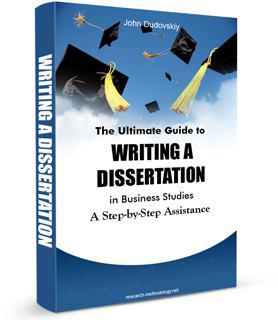
Methodology chapter of your dissertation should include discussions about the methods of data analysis. You have to explain in a brief manner how you are going to analyze the primary data you will collect employing the methods explained in this chapter. There are differences between qualitative data analysis and quantitative data analysis. In qualitative researches using interviews, focus groups, experiments etc. data analysis is going to involve identifying common patterns within the responses and critically analyzing them in order to achieve research aims and objectives. Data analysis for quantitative studies, on the other hand, involves critical analysis and interpretation of figures and numbers, and attempts to find rationale behind the emergence of main findings. Comparisons of primary research findings to the findings of the literature review are critically important for both types of studies – qualitative and quantitative. Data analysis methods in the absence of primary data collection can involve discussing common patterns, as well as, controversies within secondary data directly related to the research area. My e-book, The Ultimate Guide to Writing a Dissertation in Business Studies: a step by step assistance offers practical assistance to complete a dissertation with minimum or no stress. The e-book covers all stages of writing a dissertation starting from the selection of the research area to submitting the completed version of the work before the deadline. John Dudovskiy

Mean, mode and median are popular quantitative research methods used in business, as well as, engineering and computer sciences. In business studies these methods can be used in data comparisons such as comparing performances of two different businesses within the same period of time or comparing performance of the same business during different time periods. Mean implies average and it is the sum of a set of data divided by the number of data. Mean can prove to be an effective tool when comparing different sets of data; however this method might be disadvantaged by the impact of extreme values. Mode is the value that appears the most. A given set of data can contain more than one mode, or it can contain no mode at all. Extreme values have no impact on mode in data comparisons, however, the effectiveness of mode in data comparisons are compromised in the presence of more than one mode. Median is the middle value when the data is arranged in numerical order. It is another effective tool to compare different sets of data, however, the negative impact of extreme values is lesser on median compared to mean. My e-book, The Ultimate Guide to Writing a Dissertation in Business Studies: a step by step assistance offers practical assistance to complete a dissertation with minimum or no stress. The e-book covers all stages of writing a dissertation starting from the selection to the research area to submitting the completed version of the work within the deadline. John Dudovskiy

Dell acknowledges the importance of being perceived as socially responsible and unlike many other companies of its size and the sphere of operations, the company maintains a positon of Vice President for Corporate Responsibility. Dell has been acknowledged as the most ethical company for 2014 and 2015 by Ethisphere Institute. The company developed The Legacy of Goods 2020 Plan and its annual CSR report is update on the achievement of this plan. The Legacy of Goods 2020 comprises 21 ambitious long-term goals. Dell releases Supplier Responsibility Progress Report annually and it includes the details of CSR programs and initiatives engaged by the company. Table 3 below illustrates highlights from the latest report for 2014: Categories of CSR activities DELL Performance Educating and empowering workers Dell has been included in the list of ‘100 Best Companies To Work For’ by Working Mother AwardThe level of employee satisfaction assessed within the scope of Tell Dell global survey reached 80% in FY2015. This is an increase of 2% compared to the previous year Dell gained more than 33 awards globally during FY2015 for being an employer of choice The volume of hiring from university by Dell amounted to 24% of all external hires during the FY2015 By the end of FY2015 about 25% of eligible employees entered Dell’s flexible work programs Engagement in employee resource groups was increased from 14% in FY2014 to 18% in FY2015 In FY15, 86% of newly promoted people leaders enrolled Dell’s Foundations of Leadership training program Environmenta) energy consumption b) water consumption c) recycling d) CO2 emissions Within the scope of its Plant a Tree program, Dell has planted 678,000 trees. An estimated 463,180 tons of carbon has been sequestered thanks to this programAccording to Dell, its products consume 30% less energy compared to industry average…
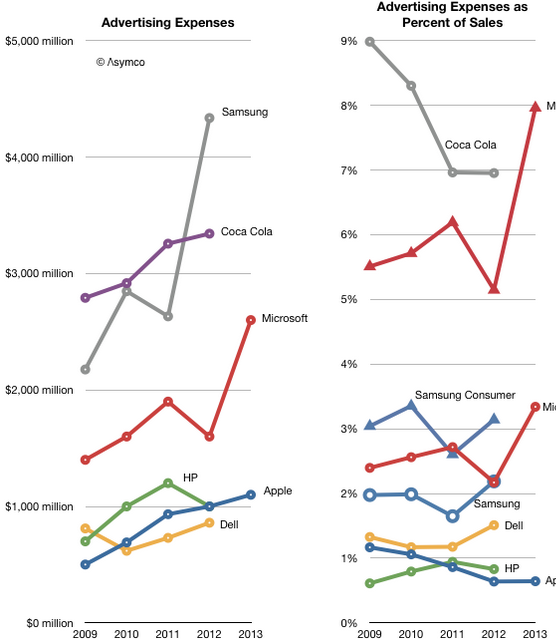
Dell is no longer under any legal obligations to reveal the details of its marketing and other expenses because the company became private as effective from September 2013. Nevertheless, data for the previous periods indicates that the company has been consistently increasing its advertising budget aftermath the global economic and financial crisis of 2007 – 2010. As it is illustrated in figure below, the same strategy has been followed by Dell’s major competitors such as Samsung and Apple, whereas marketing expenses were reduced in 2012 by Dell’s close competitor HP. Changes in Dell advertising expenses[1] Dell marketing message emphasizes low price of its products and the highest level of customization of design and experiences. The marketing message is transmitted to the target customer segment in an integrated manner via advertising, sales promotions, events and experiences, public relations, direct marketing and personal selling elements of the marketing mix. Advertising Dell relies on print and media advertising as one of its main marketing techniques. One of the latest media campaigns named “Future Ready” is a multi-million dollar attempt by Dell to promote its technology solutions for enterprise space makes an emotional appeal by illustrating the role of Dell technology in assisting a little girl receiving a new heart from a donor.[2] “Beginnings” is another noteworthy print and media marketing campaign launched by Dell and the campaign attempts to associate the brand with an entrepreneurial spirit, following the company becoming private in 2013. It is important to note that, “Beginnings” marketing video clip has emerged into a viral video in social media platforms, thus increasing the level of brand awareness to a significant extent. Sales Promotion Sales promotion as a marketing technique is used by Dell in a frequent manner. Dell official website has a dedicated page titled “Dell Coupons, Discounts…
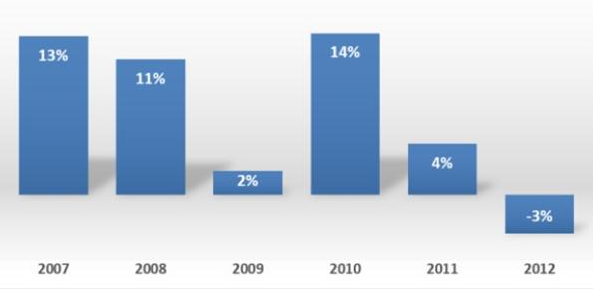
Political Factors Any corporation of a size of Dell is impacted by a set of political factors such as the level of political stability in the country, home market lobbying and international pressure groups. It is important to note that to date there is no evidence of Dell being involved in a political issue, nevertheless, the company is not immune from detrimental impact of political factors in the future. Specifically, there is a risk for Dell and other US-based computing and technology companies to become unwelcome in certain markets, particularly in Russia and China due to spying concerns sparkled mainly after the revelations of whistleblower and former CIA employee Edward Snowden. Moreover, Dell might be impacted by activities of home market lobbying and pressure groups in emerging economies advocating the interests of local computer firms, thus creating barriers for Dell in forms of trade tariffs and other instruments. Economic Factors Dell is directly impacted by a great range of economic factors that include currency exchange rates, interest rates, inflation rate, macroeconomic stability and costs of labor and raw materials. Particularly, currency exchange rate represents a major economic factor that affects Dell business performance directly and significantly because of the global scope of Dell operations. In order to address the negative impact of currency exchange rate and to gain operational efficiency, in February 2015 Dell became the biggest company that accepts bitcoins internationally[1]. Moreover, the global financial and economic crisis of 2007 – 2009 proved to have substantial detrimental impact on the growth of the global PC market, thus affecting Dell’s revenues. As it is illustrated in Figure 3 below, the growth in the global PC market amounted to 13% in 2007, however in 2009 the global PC market grew only 2% as a direct result of the crisis. It…
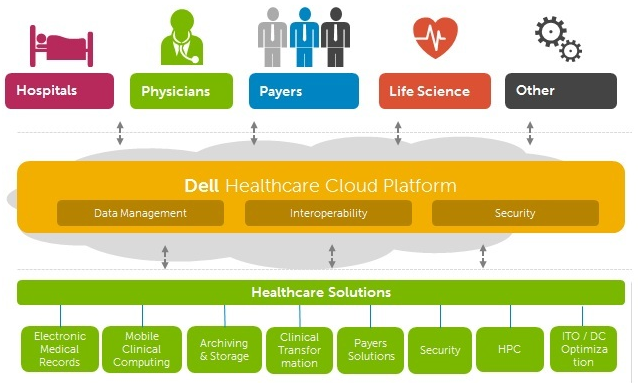
SWOT is an acronym for strengths, weaknesses, opportunities and threats related to organizations. The table below contains a brief illustration of Dell SWOT analysis: Strengths 1. Charismatic and effective leadership by Michael Dell 2. Market leadership in corporate usage. 3. Leadership in cloud 4. Leadership in healthcare sector Weaknesses 1. Lack of patents for breakthrough innovations 2. Long purchasing process 3. Extensive dependency on suppliers 4. Limited differentiation of products Opportunities 1. Investment in research and development 2. Engaging in mergers and acquisitions 3. Increasing presence in tablet and smartphone market 4. Concentrating in emerging markets Threats 1. Data security 2. Competition from emerging economies 3. Economic crisis 4. Decline of desktop and laptop market Dell SWOT Analysis Strengths 1. The company’s founder and CEO Michael Dell is a respected business leader around the globe. Michael Dell’s reputation is not constrained within consumer electronics industry and he is the first UN Global Advocate for Entrepreneurship. Starting the business in 1984 at the age of 19 from his freshman dorm room in the University of Texas, Michael Dell has been the main driving force behind the rapid growth of the business. Michael Dell stepped down as CEO in 2004 and had to return to the role in 2007 due to the decline in financial growth and the overall customer satisfaction. Michel Dell’s return has been marked with the company regaining its leadership position in the market proving his value as one of the most important assets of the business. 2. Dell products and services are popular among organizational consumers from both, private and public sectors. Dell products are used by 98% of Fortune 500 Companies[1] and 90% of Fortune 1000 companies use Dell software. It has been estimated that around 10 million small business owners function with Dell globally[2]. By…
